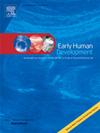Longitudinal assessments of motor performance and musculoskeletal abnormalities in preschool children with esophageal atresia
IF 2
3区 医学
Q2 OBSTETRICS & GYNECOLOGY
引用次数: 0
Abstract
Background
Children with esophageal atresia (EA) may have impaired motor performance and musculoskeletal abnormalities, but when and in whom these abnormalities develop is still unknown.
Aims
To study motor performance and musculoskeletal abnormalities from infancy to pre-school age, and to assess risk factors for poor motor performance at 24 and 48 months.
Study design
Prospective cohort study at 12, 24, and 48 months.
Subjects
Forty-six children with EA.
Outcome measures
Total and subtest scores and percentile ranks describing motor skills were obtained by using the Alberta Infant Motor Scale (AIMS) at 12 months, Peabody Developmental Motor Scale, Second Edition (PDMS-2) at 24 months, and Motor Assessment Battery for Children, Second Edition (MABC-2) at 48 months. Muscle strength was measured by Grippit, and musculoskeletal abnormalities were clinically evaluated according to a standardized protocol.
Results
The total median z-scores for AIMS, PDMS-2, and MABC-2 at group level were −0.571, −0.903, and −0.994 respectively, all significantly lower than in reference populations (p < 0.001). The decrease in motor skills between 12 and 48 months may have biological importance and was significantly more frequent in patients with more neonatal morbidity, anastomotic complications, and reduced muscle strength. The number of patients with musculoskeletal abnormalities increased from 11 % to 59 % between 24 and 48 months, but was not related to motor performance.
Conclusions
Motor performance was low from infancy, reduced longitudinally, and related to neonatal morbidity in children with EA. Musculoskeletal abnormalities increased throughout childhood, but were not related to motor performance.
学龄前食道闭锁儿童运动表现和肌肉骨骼异常的纵向评估
背景食道闭锁(EA)儿童可能有运动功能受损和肌肉骨骼异常,但这些异常何时以及在谁身上发生尚不清楚。目的研究婴儿期至学龄前运动表现和肌肉骨骼异常,并评估24和48月龄运动表现不佳的危险因素。研究设计前瞻性队列研究在12、24和48个月。研究对象46名患有ea的儿童。结果测量:在12个月时使用阿尔伯塔婴儿运动量表(AIMS),在24个月时使用皮博迪发育运动量表第二版(PDMS-2),在48个月时使用儿童运动评估量表第二版(MABC-2),获得描述运动技能的总分数、亚测试分数和百分位排名。肌肉力量由Grippit测量,肌肉骨骼异常根据标准化方案进行临床评估。结果在组水平上AIMS、PDMS-2和MABC-2的总中位数z分分别为- 0.571、- 0.903和- 0.994,均显著低于参考人群(p <;0.001)。12 - 48个月的运动技能下降可能具有生物学意义,在新生儿发病率高、吻合口并发症多、肌肉力量减弱的患者中更为常见。在24至48个月期间,肌肉骨骼异常患者的数量从11%增加到59%,但与运动表现无关。结论EA患儿的运动表现从婴儿期开始就较低,且纵向下降,与新生儿发病率有关。整个儿童期肌肉骨骼异常增加,但与运动表现无关。
本文章由计算机程序翻译,如有差异,请以英文原文为准。
求助全文
约1分钟内获得全文
求助全文
来源期刊

Early human development
医学-妇产科学
CiteScore
4.40
自引率
4.00%
发文量
100
审稿时长
46 days
期刊介绍:
Established as an authoritative, highly cited voice on early human development, Early Human Development provides a unique opportunity for researchers and clinicians to bridge the communication gap between disciplines. Creating a forum for the productive exchange of ideas concerning early human growth and development, the journal publishes original research and clinical papers with particular emphasis on the continuum between fetal life and the perinatal period; aspects of postnatal growth influenced by early events; and the safeguarding of the quality of human survival.
The first comprehensive and interdisciplinary journal in this area of growing importance, Early Human Development offers pertinent contributions to the following subject areas:
Fetology; perinatology; pediatrics; growth and development; obstetrics; reproduction and fertility; epidemiology; behavioural sciences; nutrition and metabolism; teratology; neurology; brain biology; developmental psychology and screening.
 求助内容:
求助内容: 应助结果提醒方式:
应助结果提醒方式:


